The Second Decade 1947-1956 : “If you could come and help us…”
Eighteen new MMM foundations were completed in the Second Decade. Work was expanded where it began in Nigeria and Ireland and new work was undertaken in Tanganyika, Angola, the United States and Italy.
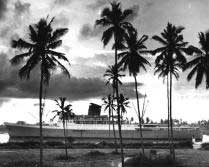 Everywhere the beginnings were humble and achievements were often accomplished by trial and error.
Everywhere the beginnings were humble and achievements were often accomplished by trial and error.
The village of Tlawi is located 3°55’S and 35°29’E, at an altitude of 1,920 meters above sea level. It is at the top of the eastern section of the Great Rift Wall, which divides in two as it passes through Tanzania. It was to this isolated and remote village that the MMM pioneers headed to make our first foundation in East Africa in 1947. It was said that if you make a friend in Tlawi, you have a friend for life!
The pioneers, Sister Helena Mulcahy, Sister Christina Hanly and Sister M. Kieran Saunders, went first to Galapo Mission to study Ki-Swahili, before opening the dispensary at Tlawi.
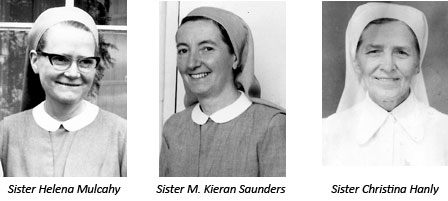
Monsignor P. Winters, a Pallotine missionary from Ireland, was responsible for running the Prefecture Apostolic of Mbulu, which had been established on 13 March 1943. Once the dispensary at Tlawi was functioning, he asked for more MMMs to take over a small church dispensary at nDareda, about fifty miles further down the Rift Valley, on a ledge of the escarpment. They arrived early in 1948 and before long nDareda was on its way to becoming a fully functioning hospital with 177 beds.
In the same year, an extension was added to the novitiate in Drogheda. In Nigeria, the work to bring Hansen’s disease (leprosy) under control was extended from Ogoja to a new foundation at Obudu, some forty miles to the east.
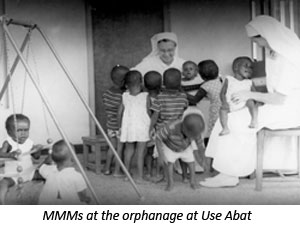 In 1949, half way between Anua and Ikot Ekpene, another foundation was made at Use Abat. Dedicated to Saint Thérèse, this was a children’s hospital and maternity unit.
In 1949, half way between Anua and Ikot Ekpene, another foundation was made at Use Abat. Dedicated to Saint Thérèse, this was a children’s hospital and maternity unit.
Also in 1949, in Ireland, a foundation was made in the town of Clonmel, at the foot of the Comeragh Mountains. A nursing home was established and a house started where postulants could receive their initial formation before entering the novitiate at Drogheda.
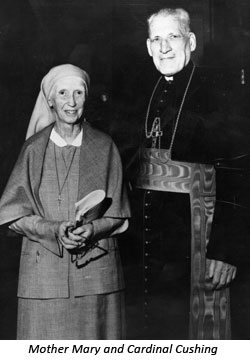 A major new challenge to MMM came in 1950, with the invitation by Archbishop (later Cardinal) Cushing of Boston to make the first MMM foundation in the United States.
A major new challenge to MMM came in 1950, with the invitation by Archbishop (later Cardinal) Cushing of Boston to make the first MMM foundation in the United States.
That was also the year when MMM founded the hospital at Urua Akpan, Nigeria, some thirty miles west of our original foundation at Anua.
In 1951 we were blessed with the gift of a small seaside bungalow at Bettystown in County Meath, Ireland, just where the River Boyne enters the Irish Sea. It is a place of quiet, just four miles from our Motherhouse at Drogheda. It was in poor condition, but by the following year repairs were completed and it was ready for occupation. Later, more needy places in Tanganyika were making pressing calls for help. We opened a hospital at Kabanga, several hundred miles west of our missions at Tlawi and nDareda. Kabanga is close to Lake Tanganyika, not far from the western border with Burundi.
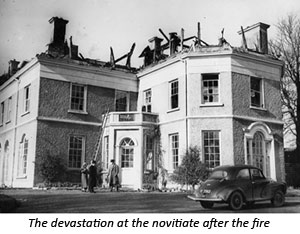 By 1952, with the novitiate extension fully occupied, normal living accommodation for the MMM Community in Drogheda seemed to be in sight for the first time since our foundation in 1937. In 1952, Shrove Tuesday fell on 13 February. As the Sisters left the chapel following Evening Prayer, shouts from passers-by alerted them to the smoke and flames coming from the top of the three-storey novitiate building. It was a bitterly cold evening, but luckily the stiff breeze was blowing the flames away from the nearby hospital. The upper floor and roof were engulfed in flames, which burned fiercely for four hours until four units of the Fire Brigade and an Army fire-fighting truck succeeded in extinguishing the blaze. Mercifully, nobody was trapped in the building, but when the fire had eventually been put out, the immediate problem was that 136 Sisters were now homeless.
By 1952, with the novitiate extension fully occupied, normal living accommodation for the MMM Community in Drogheda seemed to be in sight for the first time since our foundation in 1937. In 1952, Shrove Tuesday fell on 13 February. As the Sisters left the chapel following Evening Prayer, shouts from passers-by alerted them to the smoke and flames coming from the top of the three-storey novitiate building. It was a bitterly cold evening, but luckily the stiff breeze was blowing the flames away from the nearby hospital. The upper floor and roof were engulfed in flames, which burned fiercely for four hours until four units of the Fire Brigade and an Army fire-fighting truck succeeded in extinguishing the blaze. Mercifully, nobody was trapped in the building, but when the fire had eventually been put out, the immediate problem was that 136 Sisters were now homeless.
This disaster at our Motherhouse in Ireland was a terrible blow to Mother Mary, but did not deflect her attention from her missionary goals.

Only two days before the fire in Drogheda, the first ward of Saint Mary’s Hospital at Urua Akpan in Nigeria, was blessed and opened. For two years prior to that, an MMM nurse was living in a small mud house at Urua Akpan, running a very busy outpatient clinic. Saint Mary’s Hospital was destined to become an important health care facility, and one with a most interesting history.
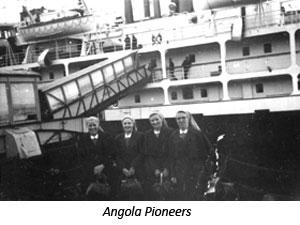 In 1952 we were invited to open our first mission in Angola, then colonized by Portugal. Three Sisters arrived the following year. Two more foundations in Europe were made in 1952. One was in Ireland, in Waterford, where MMMs took over the running of a maternity hospital at Airmount. The other was in Italy in Naples, where we were invited to staff the Clinica Mediterranea.
In 1952 we were invited to open our first mission in Angola, then colonized by Portugal. Three Sisters arrived the following year. Two more foundations in Europe were made in 1952. One was in Ireland, in Waterford, where MMMs took over the running of a maternity hospital at Airmount. The other was in Italy in Naples, where we were invited to staff the Clinica Mediterranea.
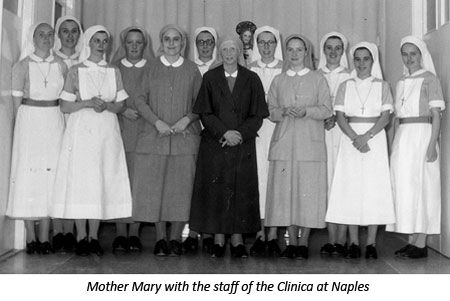
By 1953 in Nigeria, the work of bringing the widespread disease of Hansen’s disease (leprosy) under control continued to expand, with an important new foundation at Ikom, south of Ogoja.
In 1954, there were three new foundations. In Nigeria, south of Anua, a small community of Sisters settled at Akpa Utong to provide services in a maternity unit and children’s hospital. In Ireland, we were invited to 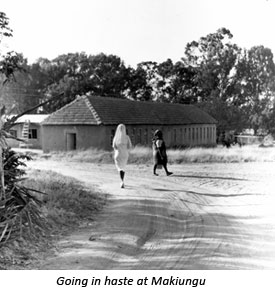 Killybegs in County Donegal. This was another home where Sisters on leave from overseas could rest and recuperate, while we cared for the elderly and lovable Bishop McGinley, who had retired from his work in Carmel-by-the-Sea in California.
Killybegs in County Donegal. This was another home where Sisters on leave from overseas could rest and recuperate, while we cared for the elderly and lovable Bishop McGinley, who had retired from his work in Carmel-by-the-Sea in California.
In Tanganyika, Monsignor Winters was concerned for the very poor and neglected people around the village of Makiungu, about twenty miles from the town of Singida. He had dreamed of having a hospital there. MMM could help, he felt, but we were becoming overstretched. We could only do so by withdrawing the Sisters from Tlawi. That was done in 1954, amidst great sadness at leaving Tlawi. We were later able to return there and run the dispensary as an outstation from nDareda.
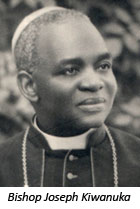 The year 1955 brought another invitation that was to have great significance for MMM. Sister Gemma Breslin feels somewhat responsible for this! One day in 1950, she was working at Kimmage Manor in Dublin, the great mission-sending house of the Spiritan (Holy Ghost) Fathers. There she met Bishop Joseph Kiwanuka, the first African to be appointed a bishop. Among the projects that brought him to Ireland was a search for Sisters to staff a hospital in his diocese at Masaka in Uganda. He told Sister Gemma his sad story: how he had asked so many different congregations to come, but they had all refused. Next day he would be going to Clonmel to put his request to Mother Mary. Sister Gemma promised him she would pray that Mother Mary would agree. As he set off, little did Sister Gemma realize that a few years later she would be among the pioneers who would make Bishop Kiwanuka’s dream come true.
The year 1955 brought another invitation that was to have great significance for MMM. Sister Gemma Breslin feels somewhat responsible for this! One day in 1950, she was working at Kimmage Manor in Dublin, the great mission-sending house of the Spiritan (Holy Ghost) Fathers. There she met Bishop Joseph Kiwanuka, the first African to be appointed a bishop. Among the projects that brought him to Ireland was a search for Sisters to staff a hospital in his diocese at Masaka in Uganda. He told Sister Gemma his sad story: how he had asked so many different congregations to come, but they had all refused. Next day he would be going to Clonmel to put his request to Mother Mary. Sister Gemma promised him she would pray that Mother Mary would agree. As he set off, little did Sister Gemma realize that a few years later she would be among the pioneers who would make Bishop Kiwanuka’s dream come true.
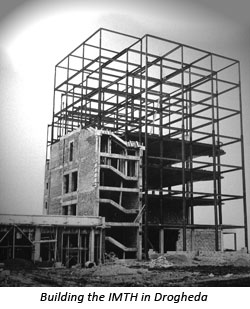 When 1956 arrived, MMMs brought the last year of their Second Decade to a close just as it had begun – with another foundation in Tanganyika. This time it was at Chala, midway between the towns of Tabora and Sumbawanga, and was part the Diocese of Karema.
When 1956 arrived, MMMs brought the last year of their Second Decade to a close just as it had begun – with another foundation in Tanganyika. This time it was at Chala, midway between the towns of Tabora and Sumbawanga, and was part the Diocese of Karema.
Meanwhile back in Ireland, the first three floors of the new International Missionary Training Hospital at Drogheda were ready for occupation. These were blessed and opened on 3 October, which at that time was the feast of Saint Thérèse of Lisieux, Co-Patron of the Missions, to whom Mother Mary Martin had a great devotion. Work continued on the four remaining stories of the new hospital, which would be opened in September 1957.
The First Decade The Third Decade
1937-1946 – The First Decade: Called to an extraordinary Adventure
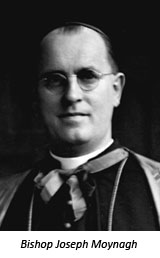 “To us who saw Mother Mary on to the boat, her going seemed to be the end of any hope for the new venture. Indeed, it seemed doubtful if she could reach Ireland alive.” So wrote Bishop Joseph Moynagh, who had just inaugurated the Medical Missionaries of Mary on April 4, 1937.
“To us who saw Mother Mary on to the boat, her going seemed to be the end of any hope for the new venture. Indeed, it seemed doubtful if she could reach Ireland alive.” So wrote Bishop Joseph Moynagh, who had just inaugurated the Medical Missionaries of Mary on April 4, 1937.
He felt that “from the human point of view the whole future of the new Congregation seemed precarious in the extreme. The Mother Foundress was on her way to Ireland extremely ill. There were but two Sisters on the Mission – Novices. There was no support financial or otherwise and the new Congregation was unknown…”
Nevertheless he added, “She left Nigeria not at all perturbed by the course of events but with that trustful smile on her face that only those who put their trust in God can have.”
Dr. Braithwaite, who had cared for her at the Government Hospital in Port Harcourt, helped her on board the Accra, then turned to Bishop Moynagh on the shore and said, “Never let me see that woman in Africa again.”
The voyage from Nigeria to Ireland gave the newly-professed Foundress a chance to regain some strength. The final hours of the voyage were delayed by fog, but by the time the Accra docked at Liverpool at 11 pm on 9 May, she was at the rail, waving to her brother, Andrew, and the future Sister Immaculata Nichols, then a young student nurse in London.
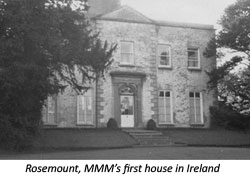
Mother Mary was not long back in Ireland before Archbishop Edward Byrne of Dublin approved the establishment of the newly-born Congregation’s first Irish home, Rosemount, in Booterstown. From here the future Sister-students would attend courses in the city hospitals and university. On the last day of 1937, MMMs moved into Rosemount,, which today houses the Congregational Centre.
Before long, the Archbishop of Armagh, Cardinal MacRory, helped her establish the first novitiate on the main street in the historic village of Collon, in the Valley of the Boyne, close to the Cistercian Monastery of Mellifont. That was opened on 11 December 1938.
In Nigeria, Mother Mary’s first two companions, Bridie O’Rourke (who became Sister M. Magdalen) and Mary Moynagh (a sister of Bishop Moynagh, who became Sister M. Joseph), completed their novitiate with the Sisters of the Holy Child at Ifuho and made their first profession of vows on 15 December 1937. 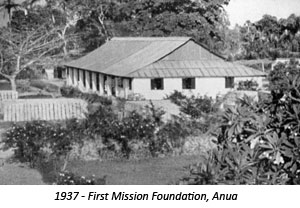 In Anua, they took up duty at Saint Luke’s Hospital, a small mission hospital with a twelve-bedded ward. Before long, it would become a widely-renowned three hundred-bed training facility until the setbacks of war several decades later.
In Anua, they took up duty at Saint Luke’s Hospital, a small mission hospital with a twelve-bedded ward. Before long, it would become a widely-renowned three hundred-bed training facility until the setbacks of war several decades later.
In Ireland, the young community began to expand in numbers, and soon was overflowing from the small house in Collon. In 1939 that problem was solved when the MMMs were asked to take over a much-needed maternity home in the town of Drogheda, about nine miles away.
It was a momentous undertaking for the Medical Missionaries of Mary, who numbered only three professed Sisters at that time. On 8 December 1939, the hospital that would later be known as Our Lady of Lourdes was registered. On 25 January 1940, the community of novices moved from Collon.
At the same time, the first issue of the magazine The Medical Missionary of Mary, was published and has continued in print to the present. It now bears the masthead Healing & Development.
By this time, World War II was raging. Although Ireland was neutral, the country was deeply affected by the restrictions in travel and the general shortages. Nevertheless, the foundation stone for the new novitiate building was blessed on May 26, 1940. Mother Mary also embarked upon much-needed extensions to the hospital in Drogheda, the first of which was completed in 1942. With it came State recognition for the first stage of training for midwifery students. Another extension was completed in 1946. By then there was further State recognition, for general nurse training.
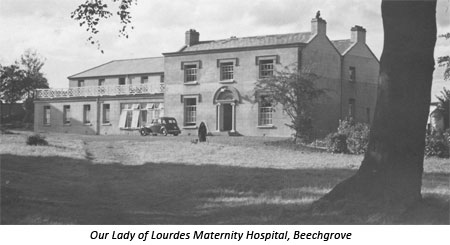
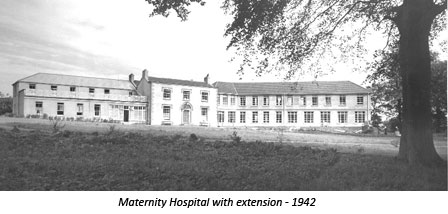
In Nigeria, meanwhile, the work at Anua was expanding to reach more and more outstations. In 1945, an invitation to spread further afield was accepted, when Bishop Thomas McGettrick asked MMM to come to Ogoja, where an Irish doctor, Joseph Barnes, had completed a survey that revealed that some 47,500 people in the area were suffering from the dreaded condition of leprosy – known today as Hansen’s disease.
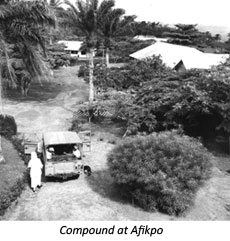 The voyage of the four pioneers who left Drogheda to make the MMM foundation in Ogoja Diocese has been well documented. They sailed in convoy through mined seas and enemy submarines to reach Nigeria.
The voyage of the four pioneers who left Drogheda to make the MMM foundation in Ogoja Diocese has been well documented. They sailed in convoy through mined seas and enemy submarines to reach Nigeria.
The work of bringing Hansen’s disease under control led to the foundation of Saint Patrick’s Hospital at Abakaliki in 1945, and in 1946, small clinics at Afikpo and Obudu, which gradually developed into much larger hospitals.
In 1946, Mother Mary, always conscious of the need to use the best media available to make known the pressing need for medical care, contacted the London-based film director, Andrew Buchanan, about making a film to be called Visitation. Of this production, Andrew Buchanan later wrote: “I have been producing films for more than twenty years, but the making of this one has been my greatest privilege.”
As the First Decade of MMM’s history was drawing to a close, more pioneers at our Motherhouse in Drogheda were packing their trunks for the first foundation in East Africa, in a land then known to us as Tanganyika.
